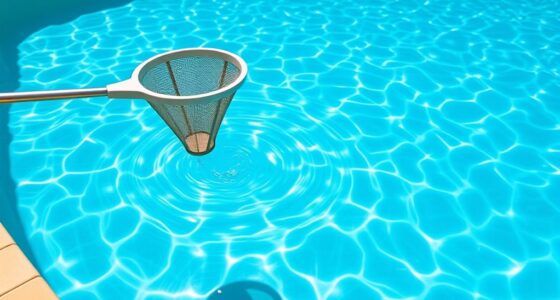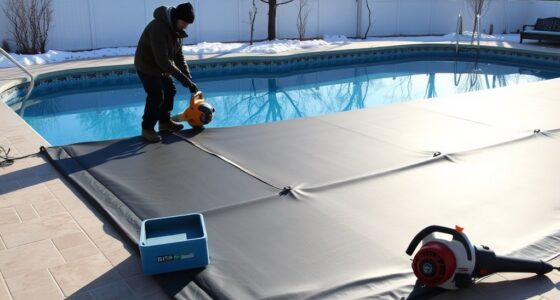To safely adjust your pool’s pH, use appropriate chemicals like muriatic acid or sodium bisulfate for lowering, added slowly with protective gear, and re-test after each addition. To raise pH, use soda ash carefully, adding small amounts and testing between doses. Always handle chemicals in well-ventilated areas and avoid overcorrection. Keep alkalinity balanced to stabilize pH levels. If you want to learn more about maintaining safe water chemistry, read on for detailed tips.
Key Takeaways
- Always test water pH levels before making adjustments to determine the correct amount of chemicals needed.
- Use protective gear and add acids or bases gradually to avoid overshooting pH levels.
- Dissolve chemicals like muriatic acid or sodium carbonate in water before adding to the pool.
- Wait several hours after each adjustment and re-test to ensure proper pH or alkalinity levels.
- Consider natural methods like aeration to raise pH or partial water changes to lower pH safely.
Understanding the Ideal Ph Range for Your Pool
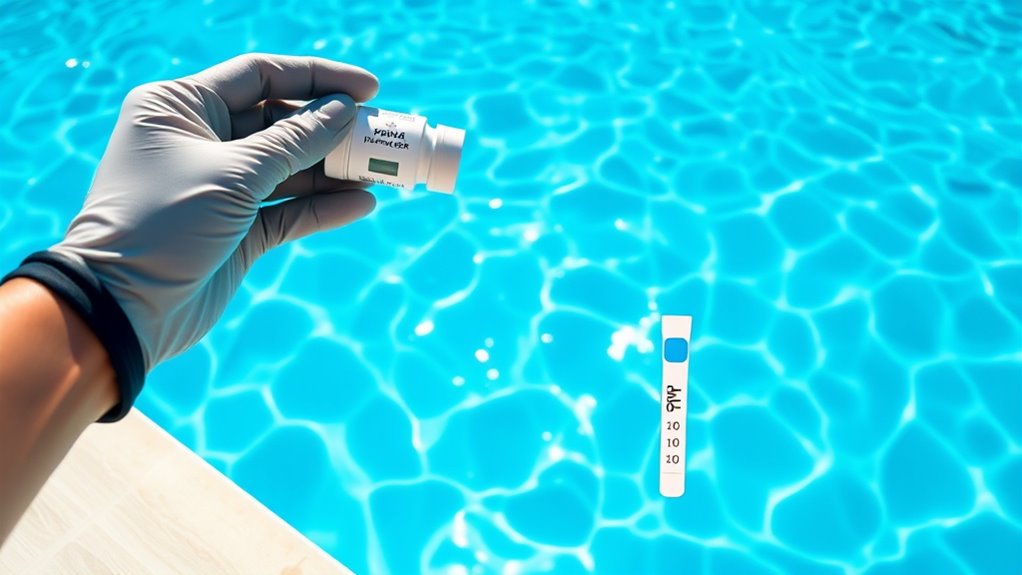
Understanding the ideal pH range for your pool is essential to keep the water safe, clear, and comfortable for swimmers. The recommended pH level is between 7.2 and 7.8, with a target of 7.4 to 7.6 for excellent results. If pH drops below 7.2, the water becomes too acidic, causing eye irritation, equipment corrosion, and damage to the pool liner. Conversely, if pH rises above 7.8, the water turns too alkaline, leading to skin irritation, scaling, and cloudiness. Maintaining the correct pH balance helps ensure swimmer comfort and protects your pool’s equipment. Regular testing and adjustments are key to keeping the pH within this range, which promotes healthy water chemistry and extends the life of your pool infrastructure. Additionally, understanding how to adjust pH levels safely is crucial for preventing damage to your pool and ensuring a pleasant swimming environment.
Safe Methods to Lower Pool Ph Using Chemicals
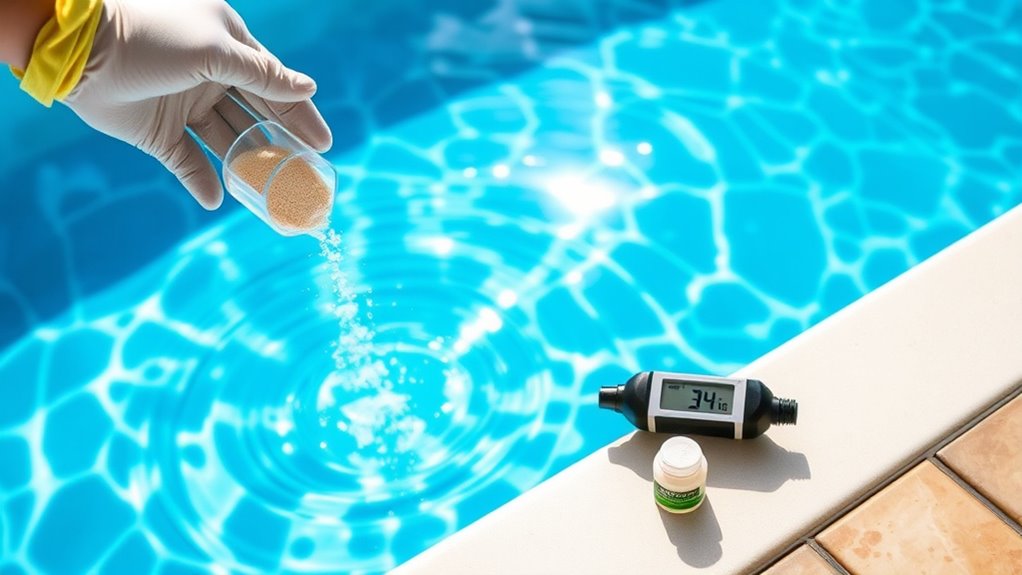
To safely lower your pool’s pH using chemicals, it’s essential to choose the right product and follow proper handling procedures. Muriatic acid and sodium bisulfate are common options. Muriatic acid is effective but requires careful handling and protective gear. Sodium bisulfate is safer and easier to manage, often labeled as “pH Down.” CO2 systems are also used in some pools for pH reduction. Always test water first, calculate the correct dosage, and add chemicals to water—not water to chemicals. Use the table below to compare options:
| Chemical | Handling & Safety |
|---|---|
| Muriatic acid | Wear protective gear; dilute before adding |
| Sodium bisulfate | Less corrosive; broadcast evenly |
| CO2 system | Use in well-ventilated areas; professional setup |
Additionally, understanding the chemical properties of each option can help you make a safer choice.
Effective Ways to Increase Pool Ph Safely
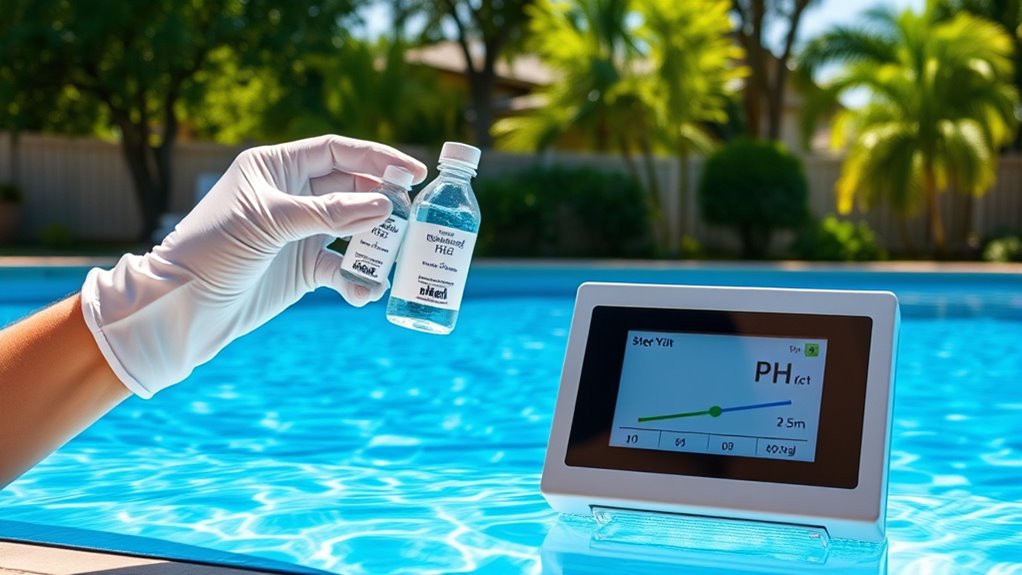
To safely raise your pool’s pH, you should use sodium carbonate carefully and add it gradually to prevent overshooting. Always test your water first and maintain a proper balance of alkalinity to avoid issues. By following these steps, you can guarantee a safe and effective pH increase without disrupting your pool’s chemistry. Proper testing ensures you add the correct amount of chemicals and maintain water balance. Maintaining a balanced comfort and support solution can also help prevent other water chemistry problems.
Use Sodium Carbonate Carefully
Using sodium carbonate to raise your pool’s pH can be effective, but it’s vital to do so carefully to avoid overshooting and causing imbalance. Start by measuring your current pH and calculating the required amount—no more than 2 pounds per 10,000 gallons per treatment. Dissolve the sodium carbonate in a bucket of water if recommended, then evenly distribute it around the pool while the pump runs. This promotes proper mixing and prevents local high pH zones. Avoid pouring directly in front of skimmers to prevent chemical suction. Always test the water after treatment to verify the pH reaches the desired range of 7.2 to 7.8. Handling soda ash with gloves and eyewear is essential, as it’s caustic and can cause irritation or burns. Proper chemical handling reduces safety risks, and understanding pool water chemistry helps ensure accurate pH adjustment.
Add Gradually for Safety
Adding pH increasers like sodium carbonate requires careful handling to avoid overshooting the target level. You should add the chemical in small increments, following the manufacturer’s dosage guidelines. For example, about 6 ounces of soda ash can raise a 10,000-gallon pool’s pH by 0.2 units, but larger doses risk rapid pH spikes and water imbalance. Always pre-dissolve solid chemicals in a bucket of pool water before pouring to ensure even distribution and prevent damage from concentrated pockets. Pour the solution around the pool perimeter, avoiding one spot, and keep the pump running to promote uniform mixing. Test the pH frequently after each addition, waiting several hours before retesting. This gradual approach helps you maintain control, prevents chemical surprises, and keeps your pool water safe and balanced. Monitoring AI-driven safety measures can assist in precise chemical adjustments and maintaining water quality.
Maintain Alkalinity Balance
Maintaining a proper alkalinity balance is essential for keeping your pool water safe, clear, and comfortable for swimmers. To increase alkalinity safely, use sodium bicarbonate (baking soda), which also slightly raises pH. For a typical 10,000-gallon pool, about 24 oz of baking soda raises alkalinity by 10 ppm. Add it evenly across the water surface to promote dissolving and avoid bypassing the filter. Always test water before adding chemicals and follow product instructions based on your pool size and current levels. Add the baking soda gradually in divided doses, waiting hours or days between applications. This approach prevents overshooting your target range of 80-120 ppm for alkalinity, which helps maintain stable pH, protect pool surfaces, and ensure sanitizer effectiveness. Regular testing is crucial to ensure your water chemistry remains balanced and safe. Additionally, understanding alkalinity buffering capacity can help you better manage your pool’s chemistry and prevent fluctuations.
Natural and Alternative Ph Adjustment Techniques

Natural and alternative methods for adjusting your pool’s pH focus on leveraging the water’s natural properties and environment to achieve balance without relying solely on chemicals. These techniques use physical processes and natural materials to modify pH levels gently.
Explore natural ways to balance your pool’s pH using environmental methods and gentle materials.
- Aeration techniques like waterfalls, fountains, or aerators help raise pH by releasing carbon dioxide into the air. Aeration increases oxygen levels, which naturally raises pH. Incorporating aeration equipment can significantly enhance pH adjustment efforts by promoting better water circulation and gas exchange.
- Partial water replacement with rainwater or low-mineral water dilutes pH naturally, avoiding harsh chemicals. This method is especially effective if your current water source has imbalanced pH levels or high mineral content.
- Organic acids, such as citric or acetic acid, can safely lower pH gradually when added in controlled amounts. Always measure carefully to prevent overcorrection and maintain safe swimming conditions.
- Introducing crushed eggshells in a mesh bag slowly releases calcium carbonate, assisting in pH stabilization without chemical intervention. This natural approach is eco-friendly and can be used regularly to support pH balance over time.
Using these methods allows you to maintain water balance while minimizing chemical use, promoting a safer, more natural swimming environment.
Balancing Alkalinity to Stabilize Ph Levels
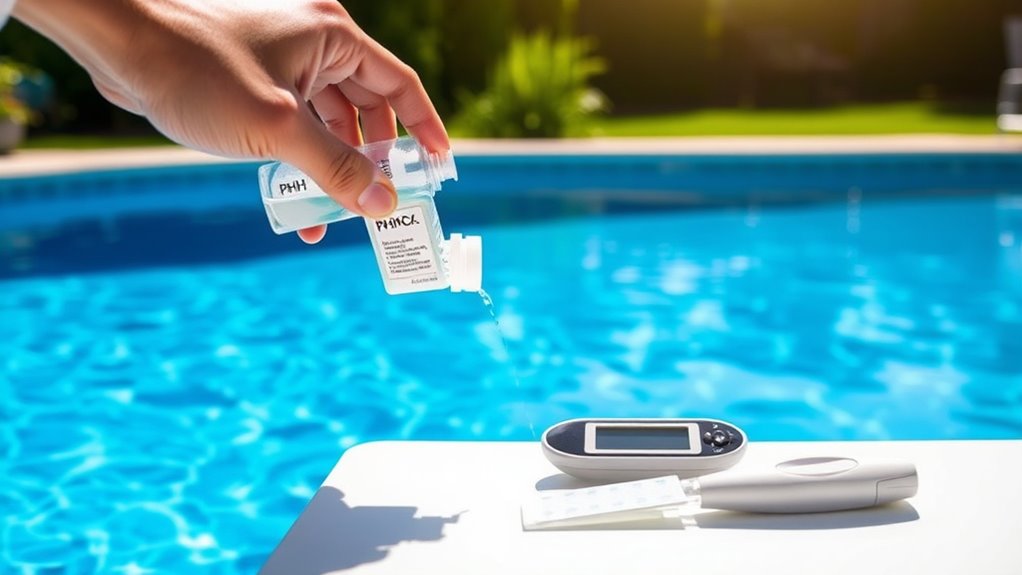
Balancing alkalinity is essential for stabilizing your pool’s pH levels, which helps prevent sudden shifts that can lead to water issues or equipment damage. Maintaining total alkalinity between 80 and 120 ppm buffers the pH, keeping it within the ideal range of 7.2 to 7.8. Low alkalinity causes unstable pH and increases corrosion risks, while high alkalinity raises pH and reduces sanitizer effectiveness. To adjust alkalinity safely, use baking soda to raise it gradually, adding about 1.4 pounds per 10,000 gallons to increase by 10 ppm. To lower alkalinity, dilute muriatic acid or sodium bisulfate before adding, following proper safety measures. Proper testing methods are crucial to ensure accurate adjustments and maintain water quality. Regularly monitoring your water chemistry helps prevent imbalances that could require more extensive treatments later. Always retest water after treatment to guarantee the alkalinity and pH levels stay balanced and within recommended ranges.
Important Safety Practices When Handling Pool Chemicals

Handling pool chemicals safely is essential to protect yourself, others, and your pool equipment. Proper storage, PPE, handling procedures, spill response, and housekeeping are critical. Use only recommended containers for storage to prevent leaks and accidental mixing. 1. Store chemicals in their original containers, in a cool, dry, well-ventilated area, away from heat and sunlight, and keep incompatible chemicals separate. Use secondary containment to prevent cross-contamination. Proper storage practices are vital, especially considering the history of hazardous incidents associated with improper chemical handling. 2. Always wear chemical-resistant gloves, goggles, and a respirator when handling chemicals, and use dedicated tools for each product to avoid cross-contamination. 3. Follow manufacturer instructions carefully, add chemicals to water (not water to chemicals), and open only one container at a time. 4. Respond quickly to spills with designated cleanup materials, keep safety equipment accessible, and train staff on emergency procedures.
Frequently Asked Questions
How Often Should I Test My Pool’s Ph Levels?
You should test your pool’s pH levels at least 2 to 3 times weekly, especially during peak swimming season or heavy use. If your pool is new, test daily until the water stabilizes. In hotter weather or after heavy rain, retest immediately. Using reliable test strips, liquid kits, or digital testers guarantees accurate readings. Regular testing helps keep your water safe, clear, and balanced, preventing damage and irritation.
Can Ph Levels Fluctuate Naturally Without Chemical Adjustments?
Imagine your pool as a living mirror, reflecting the world around it. Yes, pH levels can fluctuate naturally without chemical tweaks, like the changing seasons or rain’s gentle touch. Rainwater’s acidity, organic debris decay, and swimmer activity all act as silent artists, subtly shifting the balance. Environmental factors like sunlight, wind, and nearby vegetation also paint their influence, creating a dynamic, ever-changing portrait of your pool’s acidity and alkalinity.
What Are the Signs of Improperly Balanced Ph in My Pool?
You’ll notice signs like cloudy water, eye and skin irritation, and stain buildup on pool surfaces, indicating pH imbalance. If the water feels harsh or causes corrosion on metal parts, it’s likely too acidic. Conversely, if you see scale deposits, murky water, or your chlorine isn’t working effectively, the pH is probably too high. These signs help you identify when your pool’s pH needs adjustment for safe, clear swimming conditions.
How Long Does It Take for Chemicals to Adjust Ph After Application?
After applying pH chemicals, it typically takes at least 6 hours of continuous pump operation for the water to fully react and stabilize. You should wait this period before retesting, as chemical reactions happen gradually. During this time, keep the pump running to ensure even distribution and thorough mixing. Avoid swimming during this period to prevent irritation and ensure accurate pH readings once the waiting time has passed.
Is It Safe to Swim Immediately After Ph Adjustments?
You shouldn’t swim immediately after pH adjustments. Wait at least 20 to 30 minutes, ensuring your pool’s pump and filter run continuously for proper chemical circulation. Always test the water afterward to confirm pH is between 7.2 and 7.8 and chlorine levels are within the safe range. This careful approach helps prevent skin irritation, eye discomfort, and chemical exposure, keeping your pool safe for swimming.
Conclusion
Maintaining the right pH in your pool is like tending a delicate garden—you need the right tools and patience. By understanding the ideal pH range and using safe methods to adjust it, you’ll keep your pool sparkling and safe for everyone. Remember, balancing your pool’s chemistry is a dance—you lead with caution, and your pool will follow happily. Keep safety in mind, and enjoy the clear, inviting water you’ve worked to achieve.



